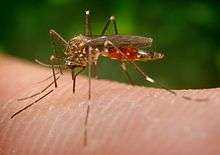Aedes japonicus
| Aedes japonicus | |
|---|---|
 | |
| Scientific classification | |
| Kingdom: | Animalia |
| Phylum: | Arthropoda |
| Class: | Insecta |
| Order: | Diptera |
| Family: | Culicidae |
| Genus: | Aedes |
| Subgenus: | Finlaya |
| Species: | Ae. japonicus |
| Binomial name | |
| Aedes japonicus (Theobald, 1901) | |
Aedes japonicus was originally described in 1901 from Tokyo, Japan, the island of Honshu being its native range,[1] but is now found in Belgium, China, France, Japan, South Korea, Panama, Spain,[2] Russia, Taiwan, and the contiguous lower 48 United States.[3] It was first recorded in New York and New Jersey in 1998.[4] Its range is expected to eventually include much of North America, Europe, Asia, and parts of Hawaii.[5]
Bionomics
Adults live in forested areas and are day biters, but are apparently reluctant to bite humans.[3] In the laboratory, they feed on chicks and mice but not on reptiles or amphibians.[3] Larvae occur in a wide variety of natural and artificial water retainers such as tree holes and rock holes, usually preferring shaded places and water rich in organic matter. They are found from early spring to early autumn in their native habitat of Central Japan.[3] They overwinter as eggs in cooler regions and larvae in warmer regions.[3]
Description
Adults have a distinctive bronze-colored, lyre-shaped pattern on the scutum, and larvae have a linear arrangement of branched frontal setae and a strongly spiculated anal saddle.[6]
Medical Importance
Aedes japonicus is capable of experimental transmission of West Nile Virus and is considered to be an active vector of West Nile virus disease with its associated syndromes.[3] Its interactions with other known disease vectors give it the potential to influence the ecology of other vector-borne diseases.[5]
References
- ↑ F. V. Theobald. 1901. A Monograph of the Culicidae or Mosquitoes. London: British Museum (Natural History). Vol. 1: 385; http://www.mosquitocatalog.org/files/pdfs/131700-32.PDF.
- ↑ "Así se descubrió el "Aedes Japonicus" en Anes". La Voz de Asturias (in Spanish). 2018-08-03. Retrieved 2018-08-09.
- 1 2 3 4 5 6 Thomas V. Gaffigan, Richard C. Wilkerson, James E. Pecor, Judith A. Stoffer and Thomas Anderson: "Aedes (Fin.) japonicus" in Systematic Catalog of Culicidae, Walter Reed Biosystematics Unit, http://www.wrbu.org/SpeciesPages_non-ANO/non-ANO_A-hab/AEjap_hab.html Archived 2016-03-21 at the Wayback Machine., accessed 16 Mar 2016.
- ↑ E. L. Peyton, Scott R. Campbell, Thomas M. Candeletti, Michael Romanowski and Wayne J. Crans. 1999. Aedes (Finlaya) japonicus japonicus (Theobald), A New Introduction into the United States. Journal of the American Mosquito Control Association, 15(2):238-241; https://archive.org/stream/cbarchive_103746_aedesfinlayajaponicusjaponicus1999/JAMCA_V15_N2_P238-241_djvu.txt
- 1 2 Michael G. Kaufman and Dina M. Fonseca. 2014. Invasion Biology of Aedes japonicus japonicus (Diptera: Culicidae). Annu. Rev. Entomol., 59: 31–49; http://vectorbio.rutgers.edu/publications/Kaufman2014InvasionBiologyjaponicus.pdf.
- ↑ Kaufman, Michael G.; Fonseca, Dina M. (2014). "Invasion Biology of Aedes japonicus japonicus (Diptera: Culicidae)". Annual Review of Entomology. 59: 31–49. doi:10.1146/annurev-ento-011613-162012. ISSN 0066-4170. PMC 4106299. PMID 24397520.